 W
WThe Battle of Abu Tellul was fought on 14 July 1918 during the Sinai and Palestine Campaign of World War I after German and Ottoman Empire forces attacked the British Empire garrison in the Jordan Valley. The valley had been occupied by the Egyptian Expeditionary Force (EEF) from February 1918 when Jericho was captured. Following two raids east of the River Jordan by the EEF the first in March and second in April the defence of the valley became the responsibility of the Desert Mounted Corps.
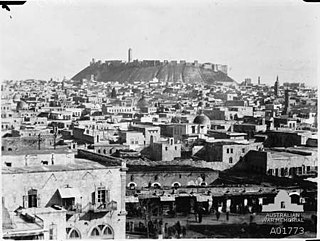 W
WThe Battle of Aleppo was fought on 25 October 1918, when Prince Feisal's Sherifial Forces captured the city during the Pursuit to Haritan from Damascus, in the last days of the Sinai and Palestine Campaign in the First World War.
 W
WThe Battle of Amara, also known as the Second Battle of Qurna, was a military engagement between the forces of the British and Ottoman Empires during the Mesopotamian Campaign of World War I. The battle took place in the flooded marshes and islands along the Tigris river between the towns of Qurna and Amara and resulted in the British capture of Amara and rout of Ottoman forces in the area.
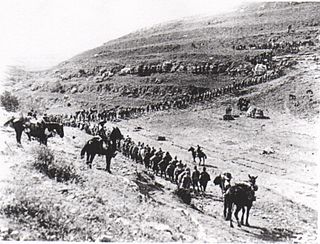 W
WThe First Transjordan attack on Amman and to their enemy as the First Battle of the Jordan took place between 21 March and 2 April 1918, as a consequence of the successful Battle of Tell 'Asur which occurred after the Capture of Jericho in February and the Occupation of the Jordan Valley began, during the Sinai and Palestine Campaign of World War I. During the First Transjordan attack large incursions into Ottoman territory occurred. Firstly the Passage of the Jordan River, was successfully captured between 21 and 23 March, followed by the first occupation of Es Salt in the hills of Moab between 24 and 25 March. The First Battle of Amman took place between 27 and 31 March when the Anzac Mounted Division and the Imperial Camel Corps Brigade were reinforced by two battalions of 181st Brigade followed by a second two battalions from the 180th Brigade and artillery. The Fourth Army headquarters located in Amman was strongly garrisoned and during the battle received reinforcements on the Hejaz railway, the strength of which eventually forced the attacking force to retire back to the Jordan Valley between 31 March and 2 April. The Jordan Valley would continue to be occupied by the Egyptian Expeditionary Force (EEF) through the summer until the middle of September 1918 when the Battle of Megiddo began.
 W
WThe First Battle of Amman was fought from 27 to 31 March 1918 during the First Transjordan attack on Amman of the Sinai and Palestine Campaign of the First World War. The 60th (London) Division and the Anzac Mounted Division attacked the Ottoman garrison at Amman deep in enemy occupied territory, 48 kilometres (30 mi) from their front line, after capturing Es Salt and Shunet Nimrin. The Egyptian Expeditionary Force (EEF) was successfully counterattacked by Ottoman Empire forces forcing them to retreat back to the bridgeheads captured on the Jordan River.
 W
WThe second attack on ANZAC Cove was an engagement during the Gallipoli Campaign of the First World War. The attack was conducted by the forces of the Ottoman Turkish Empire, against the forces of the British Empire defending the cove.
 W
WThe third attack on Anzac Cove was an engagement during the Gallipoli Campaign of the First World War. The attack was conducted by the forces of the Ottoman Turkish Empire, against the forces of the British Empire defending the cove.
 W
WThe landing at Anzac Cove on Sunday, 25 April 1915, also known as the landing at Gaba Tepe, and to the Turks as the Arıburnu Battle, was part of the amphibious invasion of the Gallipoli Peninsula by the forces of the British Empire, which began the land phase of the Gallipoli Campaign of the First World War.
 W
WThe Battle of Armentières was fought by German and Franco-British forces in northern France in October 1914, during reciprocal attempts by the armies to envelop the northern flank of their opponent, which has been called the Race to the Sea. Troops of the British Expeditionary Force (BEF) moved north from the Aisne front in early October and then joined in a general advance with French troops further south, pushing German cavalry and Jäger back towards Lille until 19 October. German infantry reinforcements of the 6th Army arrived in the area during October.
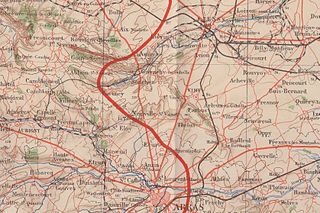 W
WThe Second Battle of Artois from 9 May to 18 June 1915, took place on the Western Front during the First World War. A German-held salient from Reims to Amiens had been formed in 1914 which menaced communications between Paris and the unoccupied parts of northern France. A reciprocal French advance eastwards in Artois could cut the rail lines supplying the German armies between Arras and Reims. French operations in Artois, Champagne and Alsace from November–December 1914, led General Joseph Joffre, Generalissimo and head of Grand Quartier Général (GQG), to continue the offensive in Champagne against the German southern rail supply route and to plan an offensive in Artois against the lines from Germany supplying the German armies in the north.
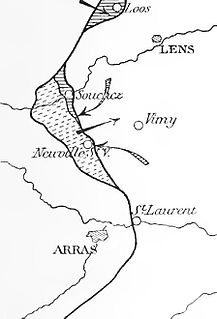 W
WThe Third Battle of Artois, was fought by the French Tenth Army against the German 6th Army on the Western Front of the First World War. The battle included the Battle of Loos by the British First Army. The offensive, meant to complement the Second Battle of Champagne, was the last attempt of 1915 by Joseph Joffre, the French commander-in-chief, to exploit an Allied numerical advantage over Germany. Simultaneous attacks were planned in Champagne-Ardenne to capture the railway at Attigny and in Artois to take the line through Douai to force a German withdrawal from the Noyon salient.
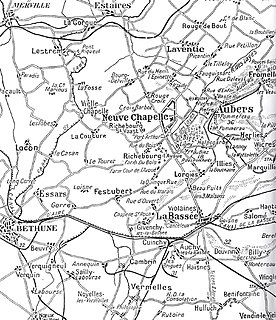 W
WThe Battle of Aubers was a British offensive on the Western Front on 9 May 1915 during the First World War. The battle was part of the British contribution to the Second Battle of Artois, a Franco-British offensive intended to exploit the German diversion of troops to the Eastern Front. The French Tenth Army was to attack the German 6th Army north of Arras and capture Vimy Ridge, preparatory to an advance on Cambrai and Douai. The British First Army, on the left (northern) flank of the Tenth Army, was to attack on the same day and widen the gap in the German defences expected to be made by the Tenth Army and to fix German troops north of La Bassée Canal.
 W
WThe Battle for Baby 700, was an engagement fought during the Gallipoli Campaign of the First World War, between the forces of the British Empire and the Ottoman Turkish Empire.
 W
WThe Fall of Baghdad occurred during the Mesopotamia Campaign, fought between the forces of the British Empire and the Ottoman Empire in the First World War.
 W
WThe Battle of Basra was a battle of World War I which took place south of the city of Basra between British and Ottoman troops from November 11 to November 22, 1914. The battle resulted in the British capture of Basra.
 W
WThe First Battle of Champagne was fought from 20 December 1914 – 17 March 1915 in World War I in the Champagne region of France and was the second offensive by the Allies against the German Empire since mobile warfare had ended after the First Battle of Ypres in Flanders (19 October – 22 November 1914). The battle was fought by the French Fourth Army and the German 3rd Army. The offensive was part of a French strategy to attack the Noyon Salient, a large bulge in the new Western Front, which ran from Switzerland to the North Sea. The First Battle of Artois began on the northern flank of the salient on 17 December and the offensive against the southern flank in Champagne began three days later.
 W
WThe Battle of Ctesiphon was fought in November 1915 by the British Empire, against the Ottoman Empire, within the Mesopotamian Campaign of World War I.
 W
WThe Capture of Damascus occurred on 1 October 1918 after the capture of Haifa and the victory at the Battle of Samakh which opened the way for the pursuit north from the Sea of Galilee and the Third Transjordan attack which opened the way to Deraa and the inland pursuit, after the decisive Egyptian Expeditionary Force victory at the Battle of Megiddo during the Sinai and Palestine Campaign of World War I. Damascus was captured when Desert Mounted Corps and Prince Feisal's Sherifial Hejaz Army encircled the city, after a cavalry pursuit northwards along the two main roads to Damascus. During the pursuit to Damascus, many rearguards established by remnants of the Ottoman Fourth, Seventh and Eighth Armies were attacked and captured by Prince Feisal's Sherifial Army, Desert Mounted Corps' Australian Mounted Division the 4th and the 5th Cavalry Divisions. The important tactical success of capturing Damascus resulted in political manoeuvring by representatives from France, Britain and Prince Feisal's force.
 W
WThe Battle of Dujaila was fought on 8 March 1916, between British and Ottoman forces during the First World War. The Ottoman forces, led by Colmar Freiherr von der Goltz were besieging Kut, when the Anglo-Indian relief force, led by Lieutenant-General Fenton Aylmer, attempted to relieve the city. The attempt failed, and Aylmer lost 4,000 men.
 W
WThe Fao Landing occurred from November 6, 1914 to November 8, 1914 with British forces attacking the Ottoman stronghold of Fao and its fortress. The landing was met with little resistance from the Turkish defenders who fled after intense shelling. It was the first military operation of the Mesopotamian Campaign of World War I which was carried out to protect the British Empire's oil supplies in the Persian Gulf.
 W
WThe Battle of Festubert was an attack by the British army in the Artois region of France on the western front during World War I. The offensive formed part of a series of attacks by the French Tenth Army and the British First Army in the Second Battle of Artois (3 May – 18 June 1915). After the failure of the breakthrough attempt by the First Army in the attack at Aubers Ridge tactics of a short hurricane bombardment and an infantry advance with unlimited objectives, were replaced by the French practice of slow and deliberate artillery-fire intended to prepare the way for an infantry attack.
 W
WThe Gallipoli campaign was a military campaign in the First World War that took place on the Gallipoli peninsula, from 17 February 1915 to 9 January 1916. The Entente powers, Britain, France and Russia, sought to weaken the Ottoman Empire, one of the Central Powers, by taking control of the Turkish straits. This would expose the Ottoman capital at Constantinople to bombardment by Allied battleships and cut it off from the Asian part of the empire. With Turkey defeated, the Suez canal would be safe, and a year-round Allied supply route could be opened through the Black Sea to warm water ports in Russia.
 W
WThe German invasion of Belgium was a military campaign which began on 4 August 1914. Earlier, on 24 July, the Belgian government had announced that if war came it would uphold its historic neutrality. The Belgian government mobilised its armed forces on 31 July and a state of heightened alert was proclaimed in Germany. On 2 August, the German government sent an ultimatum to Belgium, demanding passage through the country, and German forces invaded Luxembourg. Two days later, the Belgian government refused the demands and the British government guaranteed military support to Belgium. The German government declared war on Belgium on 4 August, troops crossed the border and began the Battle of Liège.
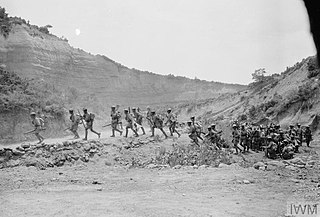 W
WThe Battle of Gully Ravine (Zığındere) was a World War I battle fought at Cape Helles on the Gallipoli peninsula. By June 1915 all thoughts the Allies had of a swift decisive victory over the Ottoman Empire had vanished. The preceding Third Battle of Krithia and the attack at Gully Ravine had limited objectives and had much in common with the trench warfare prevailing on the Western Front. Unlike previous Allied attacks at Helles, the Gully Ravine action was largely successful at achieving its objectives though at a typically high cost in casualties.
 W
WThe Battle of Haifa was fought on 23 September 1918 towards the end of the Battle of Sharon which together with the Battle of Nablus formed the set piece Battle of Megiddo fought between 19 and 25 September during the last months of the Sinai and Palestine Campaign of the First World War. During the Battle of Haifa, the Indian 15th Cavalry Brigade, 5th Cavalry Division and part of the Desert Mounted Corps attacked rearguard forces of the Ottoman Empire that resulted in the capture of the towns of Haifa and Acre. This attack took place at the north western edge of the Esdraelon Plain 40–50 miles (64–80 km) behind the front line in the Judean Hills after the Desert Mounted Corps had occupied the plain, during the cavalry phase of the Battle of Sharon.
 W
WThe First Battle of Hanna was a World War I battle fought on the Mesopotamian front on 21 January 1916 between Ottoman Army and Anglo-Indian forces.
 W
WThe Charge at Haritan occurred on 26 October 1918 at the end of the Pursuit to Haritan during the final stages of the Sinai and Palestine Campaign of the First World War. Two regiments of the 15th Cavalry Brigade, 5th Cavalry Division, charged into the retreating remnant column of the Ottoman Turkish Army's Yildirim Army Group. Subsequently, six squadrons of the same brigade charged into a Turkish rearguard position but were counterattacked and forced to retreat.
 W
WThe Pursuit to Haritan occurred between 29 September and 26 October 1918 when the XXI Corps and Desert Mounted Corps of the Egyptian Expeditionary Force (EEF) pursued the retreating remnants of the Yildirim Army Group advanced north from Damascus after that city was captured on 1 October during the final weeks of the Sinai and Palestine Campaign of the First World War. The infantry and corps cavalry advanced from Haifa and Acre to capture the Mediterranean ports at Beirut and Tripoli between 29 September and 9 October. These captures enabled the inland pursuit to be supplied when the Desert Mounted Corps' 5th Cavalry Division resumed the pursuit on 5 October. The cavalry division occupied one after the other, Rayak, Homs, Hama. Meanwhile, Prince Feisal's Sherifial Force which advanced on the cavalry division's right flank, attacked and captured Aleppo during the night of 25/26 October after an unsuccessful daytime attack. The next day the 15th Cavalry Brigade charged a retreating column and attacked a rearguard during the Charge at Haritan near Haritan which was at first reinforced but subsequently withdrew further north.
 W
WThe Battle of Hill 60 was the last major assault of the Gallipoli Campaign. It was launched on 21 August 1915 to coincide with the attack on Scimitar Hill made from the Suvla front by Major-General H. de B. De Lisle's British IX Corps, Frederick Stopford having been replaced in the few days previous. Hill 60 was a low knoll at the northern end of the Sari Bair range which dominated the Suvla landing. Capturing this hill along with Scimitar Hill would have allowed the Anzac and Suvla landings to be securely linked.
 W
WThe Hundred Days Offensive was a series of massive Allied offensives which ended the First World War. Beginning with the Battle of Amiens on the Western Front, the Allies pushed the Central Powers back, undoing their gains from the German spring offensive. The Germans retreated to the Hindenburg Line, but the Allies broke through the line with a series of victories, starting with the Battle of St Quentin Canal on 29 September. The offensive, together with a revolution breaking out in Germany, led to the Armistice of 11 November 1918 which ended the war with an Allied victory. The term "Hundred Days Offensive" does not refer to a battle or strategy, but rather the rapid series of Allied victories against which the German Army had no reply.
 W
WThe Charge at Irbid occurred on 26 September 1918 as a consequence of the victory at the Battle of Megiddo during the subsequent inland pursuit by Desert Mounted Corps to capture Damascus in the Sinai and Palestine Campaign of World War I. The charge occurred when the 2nd Lancers of the 10th Cavalry Brigade, 4th Cavalry Division, attacked the Ottoman Army garrison defending the town of Irbid.
 W
WThe Battle of Jassin was a World War I battle that took place on 18– 19 January 1915 at Jassin on the German East African side of the border with British East Africa between a German Schutztruppe force and British and Indian troops. Jassin had been occupied by the British in order to secure the border between British East Africa and German territory, but was weakly defended by a garrison of four companies of Indian troops, commanded by Colonel Raghbir Singh and numbering a little over 300 men. Colonel Raghbir Singh was killed during the battle.
 W
WThe Capture of Jenin occurred on 20 September 1918, during the Battle of Sharon which together with the Battle of Nablus formed the set piece Battle of Megiddo fought between 19 and 25 September during the last months of the Sinai and Palestine Campaign of the First World War. During the cavalry phase of the Battle of Sharon carried out by the Desert Mounted Corps, the 3rd Light Horse Brigade, Australian Mounted Division attacked and captured the town of Jenin located on the southern edge of the Esdraelon Plain 40–50 miles (64–80 km) behind the front line in the Judean Hills. The Australian light horse captured about 2,000 prisoners, the main supply base and the ordnance depot of the Seventh and the Eighth Armies in and near the town. They also cut the main road from Nablus and a further 6,000 Ottoman Empire and German Empire prisoners, were subsequently captured as they attempted to retreat away from the Judean Hills.
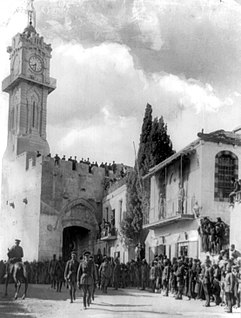 W
WThe Battle of Jerusalem occurred during the British Empire's "Jerusalem Operations" against the Ottoman Empire, in World War I, when fighting for the city developed from 17 November, continuing after the surrender until 30 December 1917, to secure the final objective of the Southern Palestine Offensive during the Sinai and Palestine Campaign of World War I. Before Jerusalem could be secured, two battles were recognised by the British as being fought in the Judean Hills to the north and east of the Hebron–Junction Station line. These were the Battle of Nebi Samwill from 17 to 24 November and the Defence of Jerusalem from 26 to 30 December 1917. They also recognised within these Jerusalem Operations, the successful second attempt on 21 and 22 December 1917 to advance across the Nahr el Auja, as the Battle of Jaffa, although Jaffa had been occupied as a consequence of the Battle of Mughar Ridge on 16 November.
 W
WThe Charge at Khan Ayash occurred on 2 October 1918 about 17 miles (27 km) north of Damascus after the pursuit to, and capture of Damascus, which followed the decisive Egyptian Expeditionary Force victory at the Battle of Megiddo on 25 September during the Sinai and Palestine Campaign of World War I. After Damascus had been encircled by Desert Mounted Corps on 30 September, the 3rd Light Horse Brigade advanced through the city on 1 October to charge and capture remnants of the Ottoman Yildirim Army Group withdrawing along the road north to Rayak and Homs.
 W
WThe action of Khan Baghdadi was an engagement during the Mesopotamian campaign in World War I.
 W
WThe Third Battle of Krithia, fought on the Gallipoli peninsula during World War I, was the last in a series of Allied attacks against the Ottoman defences aimed at achieving the original objectives of 25 April 1915. The previous failures in the first and second battles resulted in a less ambitious plan being developed for the attack, but the outcome was another costly failure for the Allies. The allied aim was, as always to facilitate the capture of Alçı Tepe which commanded most of the peninsula.
 W
WThe siege of Kut Al Amara, also known as the first battle of Kut, was the besieging of an 8,000 strong British Army garrison in the town of Kut, 160 kilometres (100 mi) south of Baghdad, by the Ottoman Army. In 1915, its population was around 6,500. Following the surrender of the garrison on 29 April 1916, the survivors of the siege were marched to imprisonment at Aleppo, during which many died. Historian Christopher Catherwood has called the siege "the worst defeat of the Allies in World War I". Ten months later, the British Indian Army, consisting almost entirely of newly recruited troops from Western India, conquered Kut, Baghdad and other regions in between in the Fall of Baghdad.
 W
WThe Second Battle of Kut was fought on 23 February 1917, between British and Ottoman forces at Kut, Mesopotamia.
 W
WThe Battle of Latema Nek was a battle of the East African Campaign in World War I.
 W
WThe actions of the Hohenzollern Redoubt took place on the Western Front in World War I from 13 to 19 October 1915, at the Hohenzollern Redoubt near Auchy-les-Mines in France. In the aftermath of the Battle of Loos, the 9th (Scottish) Division captured the strongpoint and then lost it to a German counter-attack. The British attack on 13 October failed and resulted in 3,643 casualties, mostly in the first few minutes. In the History of the Great War, James Edmonds wrote that "The fighting [from 13 to 14 October] had not improved the general situation in any way and had brought nothing but useless slaughter of infantry".
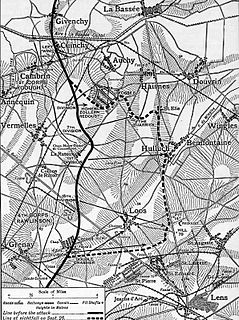 W
WThe Battle of Loos took place from 25 September to 8 October 1915 in France on the Western Front, during the First World War. It was the biggest British attack of 1915, the first time that the British used poison gas and the first mass engagement of New Army units. The French and British tried to break through the German defences in Artois and Champagne and restore a war of movement. Despite improved methods, more ammunition and better equipment, the Franco-British attacks were largely contained by the Germans, except for local losses of ground. The British gas attack failed to neutralize the defenders and the artillery bombardment was too short to destroy the barbed wire or machine gun nests. German tactical defensive proficiency was still dramatically superior to the British offensive planning and doctrine, resulting in a British defeat.
 W
WThe Battle of Megiddo also known in Turkish as the Nablus Hezimeti, or the Nablus Yarması was fought between 19 and 25 September 1918, on the Plain of Sharon, in front of Tulkarm, Tabsor and Arara in the Judean Hills as well as on the Esdralon Plain at Nazareth, Afulah, Beisan, Jenin and Samakh. Its name, which has been described as "perhaps misleading" since very limited fighting took place near Tel Megiddo, was chosen by Allenby for its biblical and symbolic resonance.
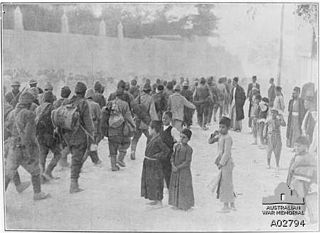 W
WThe Battle of Nablus took place, together with the Battle of Sharon during the set piece Battle of Megiddo between 19 and 25 September 1918 in the last months of the Sinai and Palestine Campaign of the First World War. Fighting took place in the Judean Hills where the British Empire's XX Corps attacked the Ottoman Empire's Yildirim Army Group's Seventh Army defending their line in front of Nablus. This battle was also fought on the right flank in the Jordan Valley, where Chaytor's Force attacked and captured the Jordan River crossings, before attacking the Fourth Army at Es Salt and Amman capturing many thousands of prisoners and extensive territory. The Battle of Nablus began half a day after the main Battle of Sharon, which was fought on the Mediterranean section of the front line where the XXI Corps attacked the Eighth Army defending the line in front of Tulkarm and Tabsor and the Desert Mounted Corps which rode north to capture the Esdrealon Plain. Together these two battles, known as the Battle of Megiddo, began the Final Offensive of the war in the Sinai and Palestine campaign.
 W
WThe Battle of Nasiriyah was a battle in World War I that took place in the Mesopotamian city of Nasiriyah between British and Ottoman forces in July 1915. It was a pivotal battle in the Mesopotamian campaign of World War I and saw 5,000 British and Indian troops face off against a Turkish garrison of a similar number. British and Indian forces under the command of Lieutenant General Sir George Frederick Gorringe attacked Nasiriyah with the intention of protecting the British stronghold of Basra and destroying a major Turkish supply center in the region. British forces defeated the Turkish forces in Nasiriyah and it became the latest addition to a long string of successes against Ottoman forces in the campaign, coming right after the capture of Amara and the Battle of Qurna.
 W
WThe Battle of Nazareth began on 20 September 1918, during the Battle of Sharon, which together with the Battle of Nablus formed the set piece Battle of Megiddo fought during the last months of the Sinai and Palestine Campaign of the First World War. During the cavalry phase of the Battle of Sharon the Desert Mounted Corps rode to the Esdraelon Plain 40 and 50 miles behind the front line in the Judean Hills. At Nazareth on the plain, the 13th Cavalry Brigade of the 5th Cavalry Division attempted to capture the town and the headquarters of the Yildirim Army Group which was eventually captured the following day after the garrison had withdrawn.
 W
WThe Raid on Nekhl was the second of three battles by British forces to recapture the Sinai Peninsula during the Sinai and Palestine Campaign of World War I. Egyptian Expeditionary Force (EEF) mounted forces travelled into the centre of the Sinai Peninsula to attack and push the last Ottoman Army garrisons back into Palestine.
 W
WThe Battle of Neuve Chapelle took place in the First World War in the Artois region of France. The attack was intended to cause a rupture in the German lines, which would then be exploited with a rush to the Aubers Ridge and possibly Lille. A French assault at Vimy Ridge on the Artois plateau was also planned to threaten the road, rail and canal junctions at La Bassée from the south as the British attacked from the north. The British attackers broke through German defences in a salient at the village of Neuve-Chapelle but the success could not be exploited.
 W
WThe Battle of Qurna, was between British forces and Ottoman forces that had retreated from Basra, which they lost at the Battle of Basra (1914) during the Mesopotamian campaign of World War I.
 W
WThe Battle of Shaiba was a battle of World War I fought between British and Ottoman forces, the latter trying to retake the city of Basra from the British.
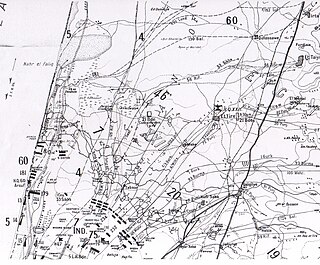 W
WThe Battle of Sharon fought between 19 and 25 September 1918, began the set piece Battle of Megiddo half a day before the Battle of Nablus, in which large formations engaged and responded to movements by the opposition, according to pre-existing plans, in the last months of the Sinai and Palestine Campaign of World War I. The fighting took place over a wide area from the Mediterranean Sea east to the Rafat salient in the Judean Hills. Here the Egyptian Expeditionary Force (EEF) XXI Corps with the French brigade sized Détachement Français de Palestine et de Syrie attacked the Yildirim Army Group Eighth Army's XXII Corps and German Asia Corps. The Battle of Sharon extended well behind the Ottoman front lines when the Desert Mounted Corps rode through a gap in the front line across the Plain of Sharon to occupy the Esdraelon Plain. Meanwhile, during the Battle of Nablus the XX Corps attacked Nablus while Chaytor's Force held the right flank in the Jordan Valley before advancing to secure bridges and fords across the Jordan River, to continue the encirclement the defenders in the Judean Hills. Subsequently, Chaytor's Force advanced against the Fourth Army to capture Es Salt and Amman after the Second Battle of Amman.
 W
WThe Battle of Sheikh Sa'ad occurred between 6–8 January 1916 during the Mesopotamian Campaign of the First World War. The battle took place along the banks of the Tigris River between the Anglo-Indian Tigris Corps and elements of the Ottoman Sixth Army. The engagement was the first in a series of assaults by the Tigris Corps to try to break through the Ottoman lines to relieve the besieged garrison at Kut.
 W
WThe Raid on the Suez Canal, also known as Actions on the Suez Canal, took place between 26 January and 4 February 1915 when a German-led Ottoman Army force advanced from Southern Palestine to attack the British Empire-protected Suez Canal, marking the beginning of the Sinai and Palestine Campaign (1915-1918) of World War I (1914-1918).
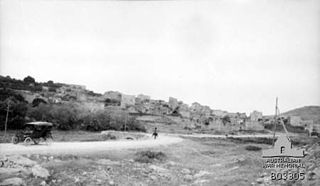 W
WThe Battle of Tabsor was fought on 19–20 September 1918 beginning the Battle of Sharon, which along with the Battle of Nablus formed the set piece Battle of Megiddo fought between 19 and 25 September in the last months of the Sinai and Palestine Campaign of the First World War. During the infantry phase of the Battle of Sharon the British Empire 60th Division, XXI Corps attacked and captured the section of the front line nearest the Mediterranean coast under cover of an intense artillery barrage including a creeping barrage and naval gunfire. This Egyptian Expeditionary Force (EEF) victory over the entrenched Ottoman Eighth Army, composed of German and Ottoman soldiers, began the Final Offensive, ultimately resulting in the destruction of the equivalent of one Ottoman army, the retreat of what remained of two others, and the capture of many thousands of prisoners and many miles of territory from the Judean Hills to the border of modern-day Turkey. After the end of the battle of Megiddo, the Desert Mounted Corps pursued the retreating soldiers to Damascus, six days later. By the time the Armistice of Mudros was signed between the Allies and the Ottoman Empire five weeks later, Aleppo had been captured.
 W
WThe Battle of Tanga, sometimes also known as the Battle of the Bees, was the unsuccessful attack by the British Indian Expeditionary Force "B" under Major General A.E. Aitken to capture German East Africa during the First World War in concert with the invasion Force "C" near Longido on the slopes of Mount Kilimanjaro. It was the first major event of the war in Eastern Africa and saw the British defeated by a significantly smaller force of German Askaris and colonial volunteers under Lieutenant Colonel Paul von Lettow-Vorbeck. It was the beginning of the East African Campaign of World War I, and is considered one of greatest victories of the Schutztruppe in Africa. The British retreat enabled the Schutztruppe to salvage modern equipment, medical supplies, tents, blankets, food and a number of Maxim Machine Guns which allowed them to successfully resist the allies for the rest of the War.
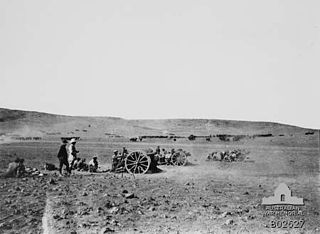 W
WThe Battle of Tel el Khuweilfe, part of the Southern Palestine Offensive, began on 1 November 1917, the day after the Egyptian Expeditionary Force (EEF) victory at the Battle of Beersheba during the Sinai and Palestine Campaign of World War I. After the Stalemate in Southern Palestine a series of coordinated attacks were launched by British Empire units on the Ottoman Empire's German commanded Yildirim Army Group's front line, which stretched from Gaza inland to Beersheba. During fighting for the town, the road from Beersheba to Jerusalem via Hebron, was cut just north of the town in the southern spur of the Judean Hills. Here Ottoman units strongly defended the road and the Seventh Army headquarters at Hebron.
 W
WThe siege of Tsingtao was the attack on the German port of Tsingtao in China during World War I by Japan and the United Kingdom. The siege was waged against Imperial Germany between 27 August and 7 November 1914. The siege was the first encounter between Japanese and German forces, the first Anglo-Japanese operation of the war, and the only major land battle in the Asian and Pacific theatre during World War I.
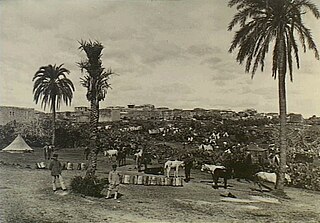 W
WThe Battle of Tulkarm took place on 19 September 1918, beginning of the Battle of Sharon, which along with the Battle of Nablus formed the set piece Battle of Megiddo fought between 19 and 25 September in the last months of the Sinai and Palestine Campaign of the First World War. During the infantry phase of the Battle of Sharon the British Empire 60th Division, XXI Corps attacked and captured the section of the front line nearest the Mediterranean coast under cover of an intense artillery barrage including a creeping barrage and naval gunfire. This Egyptian Expeditionary Force (EEF) victory over the entrenched Ottoman Eighth Army, composed of German and Ottoman soldiers, began the Final Offensive, ultimately resulting in the destruction of the equivalent of one Ottoman army, the retreat of what remained of two others, and the capture of many thousands of prisoners and many miles of territory from the Judean Hills to the border of modern-day Turkey. After the end of the battle of Megiddo, the Desert Mounted Corps pursued the retreating soldiers to Damascus, six days later. By the time an Armistice of Mudros was signed between the Allies and the Ottoman Empire five weeks later, Aleppo had been captured.
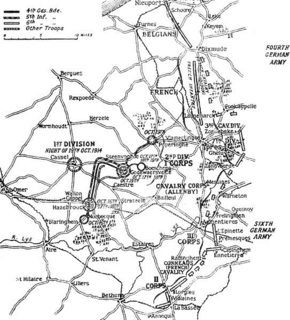 W
WThe First Battle of Ypres was a battle of the First World War, fought on the Western Front around Ypres, in West Flanders, Belgium. The battle was part of the First Battle of Flanders, in which German, French, Belgian armies and the British Expeditionary Force (BEF) fought from Arras in France to Nieuwpoort (Nieport) on the Belgian coast, from 10 October to mid-November. The battles at Ypres began at the end of the Race to the Sea, reciprocal attempts by the German and Franco-British armies to advance past the northern flank of their opponents. North of Ypres, the fighting continued in the Battle of the Yser (16–31 October), between the German 4th Army, the Belgian army and French marines.
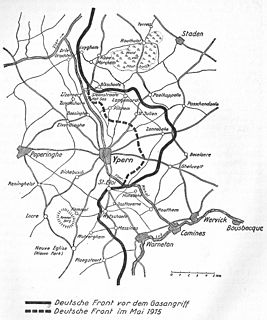 W
WDuring the First World War, the Second Battle of Ypres was fought from 22 April – 25 May 1915 for control of the strategic Flemish town of Ypres in western Belgium. The First Battle of Ypres had been fought the previous autumn. The Second Battle of Ypres was the first mass use by Germany of poison gas on the Western Front.